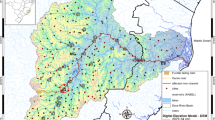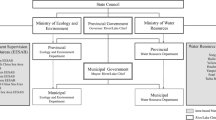Abstract
When central governments decentralize natural resource management (NRM), they often retain an interest in the local efforts and provide funding for them. Such outside investments can serve an important role in moving community-based efforts forward. At the same time, they can represent risks to the community if government resources are not stable over time. Our focus in this article is on the effects of withdrawal of government resources from community-based NRM. A critical question is how to build institutional capacity to carry on when the government funding runs out. This study compares institutional survival and coping strategies used by community-based project organizations in two different contexts, India and the United States. Despite higher links to livelihoods, community participation, and private benefits, efforts in the Indian cases exhibited lower survival rates than did those in the U.S. cases. Successful coping strategies in the U.S. context often involved tapping into existing institutions and resources. In the Indian context, successful coping strategies often involved building broad community support for the projects and creatively finding additional funding sources. On the other hand, the lack of local community interest, due to the top-down development approach and sometimes narrow benefit distribution, often challenged organizational survival and project maintenance.
Similar content being viewed by others
Notes
Mahatma Gandhi National Rural Employment Guarantee Scheme, in its guideline issued recently in 2012 states the possibility of diverting its funding to maintain or expand the assets constructed during the watershed work (GOI 2012). The earlier guidelines in 2008, was less clear about the modalities of convergence of the two programs (GOI 2008).
The present situation of availability of funding is somewhat different since the Government of India has sought a convergence between the WDPs and MGNREGS such that the post-project requirements of WDPs are met by MGNREGS funds. The primary objective of the latter project is employment generation for the economically marginalized, and sustainability of the source for employment generation is aided by repair and maintenance work of the assets of the old WDP projects.
References
Alexander J (2000) Adaptive strategies of nonprofit human services organizations in an era of devolution and new public management. Nonprofit Manag Leadersh 19(3):287–303
Arnstein SR (1969) A ladder of citizen participation. Am Inst Plan J 35:216–224
Barrett CB, Katrina K, Gibson C, Gjertsen H (2001) Conserving tropical biodiversity amid weak institutions. Bioscience 51(6):497–502
Bidwell R, Ryan C (2006) Collaborative partnership design: the implications of organizational affiliation for watershed partnerships. Soc Nat Resour 19:827–843
David RS (2008) The National Rural Employment Guarantee Act: towards governance and conservation of natural resources. In: International association for the study of the commons conference proceedings, Cheltenham, England
Ellerman D (2007) Helping self-help: the fundamental conundrum of development assistance. J Socio-Econ 36(4):561–577
Farrington J, Lobo C (1997). Scaling up participatory watershed development in India: lessons from the Indo-German watershed development programme. Natural Resource Perspectives Discussion Paper 17. Overseas Development Institute, London
Fleishman RK (2004) Watershed groups in Ohio: the effects of organizational characteristics on political behavior, accomplishments, and perceived effectiveness. M.S. thesis, The Ohio State University School of Environment and Natural Resources, Columbus, Ohio
George AL, Bennett A (2005) Case studies and theory development in the social sciences. Belfer Center for Science and International Affairs, Cambridge
Government of India (1994) Guidelines for watershed development. Department of Land Resources, Ministry of Rural Development, New Delhi
Government of India (2001) Report of the working group on watershed development, rain-fed farming and natural resource management for the tenth Five-Year Plan. Ministry of Rural Development, New Delhi
Government of India (2003) Guidelines for Hariyali. Department of Land Resources, Ministry of Rural Development, New Delhi
Government of India (GOI) (2008) Common guidelines for watershed development projects. Department of Land Resources, New Delhi
Government of India (GOI) (2012) The Mahatma Gandhi National Rural Employment Guarantee Act, Operational Guidelines(Draft Report), Ministry of Rural Development, Government of India
Gronbjerg KA (1993) Understanding nonprofit funding. Jossey-Bass, San Francisco
Grønbjerg KA (1998) Organizational behavior, organizational contingencies, and community linkages: the case of nonprofit organizations and the poor. Paper presented at the Independent Sector Spring Research Forum, San Francisco
Hadley TR, Culhane DP (1993) The status of community mental health centers ten years into block grant financing. Community Ment Health J 23(2):95–102
Hardy SD, Koontz TM (2008) Reducing nonpoint source pollution through collaboration: policies and programs across the U.S. states. Environ Manage 41(3):301–310
Joy KL, Paranjape (2004) Watershed development review: issues and prospects. Technical Report, Centre for Interdisciplinary Studies in Environment and Development, Bangalore
Kerr J, Milne G, Chhotray V, Baumann P, James AJ (2007) Managing watershed externalities in India: theory and practice. Environ Dev Sustain 9:263–281
Kirk SA, Kutchins H (1992) Diagnosis and uncertainty in mental health organizations. In: Hasenfeld Y (ed) Human services as complex organizations. Sage, Newbury Park, pp 163–183
Koehler B, Koontz TM (2008) Citizen participation in collaborative watershed partnerships. Environ Manage 41(2):143–154
Kolavall S, Kerr J (2002) Scaling up participatory watershed development in India. Dev Change 33(2):213–235
LeRoux K (2004) Nonprofit entrepreneurship: organizational responses to budget cuts among social service providers. Paper presented at the annual Midwest Political Science Association meeting, Chicago, April 15–18
Liebschutz SF (1992) Coping by nonprofit organizations during the Reagan years. Nonprofit Manag Leadersh 2(4):363–380
Manor J (2010) What do they know of India who only India know? The uses of comparative politics. Commonw Comp Politics 48(4):505–516
McMurtry SL, Netting FN, Kettner PM (1991) How nonprofits adapt to a stringent environment. Nonprofit Manag Leadersh 1(3):235–252
Narayanmoorthy A, Kshirsagar KG (2002) Watershed or command area?: an evaluation of watershed projects in Maharashtra. Artha Vijnana 44(3–4):253–290
Nikolic SS (2005) Impacts of state involvement on community-based collaborative watershed management. M.S. thesis, The Ohio State University Graduate School, Columbus, OH
Nikolic SJS, Koontz TM (2008) Nonprofit organizations in environmental management: a comparative analysis of Government impacts. J Public Admin Res Theory 18:441–463
Ohio Division of Soil and Water Resources (ODSWR) (2010) Ohio Watershed Coordinator Grant Program 2009-2010 Annual Report. Ohio Department of Natural Resources, Columbus, OH. http://www.dnr.state.oh.us/tabid/9192/Default.aspx
Ostrom E (1990) Governing the commons: the evolution of institutions for collective action. Cambridge University Press, Cambridge
Prabhakar SVRK, Srinivasan A, Shaw R (2009) Climate change and local level disaster risk reduction planning: need, opportunities and challenges. Mitig Adapt Strat Glob Change 14:7–33
Randall R, Wilson C (1989) The impact of federally imposed stress upon local government and nonprofit organizations. Adm Soc 21:3–19
Rangan H, Lane MB (2001) Indigenous peoples and forest management: comparative analysis of institutional approaches in Australia and India. Soc Nat Resour 14(2):145–160
Ratna Reddy V (2000) Sustainable watershed management: institutional perspective. Econ Political Wkly 35(40):3435–3444
Reddy VR, Soussan J (2004) Assessing the impacts of watershed development programmes: a sustainable rural livelihoods framework. Ind J Agric Econ 59(3):331–343
Sen S (2008) Watershed programmes and rural development in India. In: Wassan R, Dutta KL (eds) Water first. Sage Publications, New Delhi, pp 243–256
Sen S, Shah A, Kumar A (2008) Watershed development programmes in Madhya Pradesh: present scenario and issues for convergence. A Technical Report, FoRWARD
Shah M (2002) Rethinking watershed strategy. The Hindu, January 29, New Delhi edition
Shah A (2004) Rapporteur’s report on watershed development. Ind J Agric Econ 59(3):664–676
Sharma S (2005) Rethinking watershed development in India: strategy for the twenty-first century. In: Preparing for the next generation of watershed management programmes and projects, Asia, Watershed Management & Sustainable Mountain Development Working Paper 5, International Centre for Integrated Mountain Development, Kathmandu, Nepal
Sirianni C (2006) Can a federal regulator become a civic enabler?: watersheds at the U.S. Environmental Protection Agency. Natl Civic Rev 95(3):17–34
Turton C, Farrington J (1998) Enhancing rural livelihoods through participatory watershed development in India. Natural Resources Perspective, No. 34. Overseas Development Institute, July
Yin RK (2009) Case study research: design and methods, 4th edn. Sage Publications, Thousand Oaks
Acknowledgments
We thank the European Union and the Development Support Centre, Ahmedabad for the funding and the logistic support for this Madhya Pradesh fieldwork, which was done as part of a larger project entitled “Post- Project Management and Use of WDF In the Watershed Development Programmes in Four States.” The Ohio fieldwork was conducted as part of the Nehru-Fulbright Senior Research Grant that the second author received, during which time she was affiliated with The Ohio State University.
Author information
Authors and Affiliations
Corresponding author
Rights and permissions
About this article
Cite this article
Koontz, T.M., Sen, S. Community Responses to Government Defunding of Watershed Projects: A Comparative Study in India and the USA. Environmental Management 51, 571–585 (2013). https://doi.org/10.1007/s00267-012-0008-2
Received:
Accepted:
Published:
Issue Date:
DOI: https://doi.org/10.1007/s00267-012-0008-2




